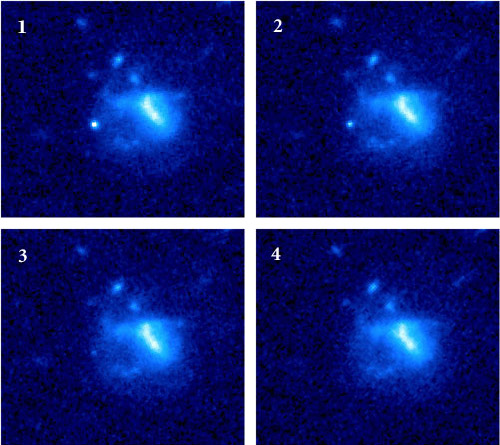Short gamma-ray bursts (GRBs) are the result of two neutron stars merging or a black hole eating a neutron star, say astrophysicists.
Scientists classify GRBs in two groups: short duration, lasting less than 2 seconds, and long duration. In the late 1990s, scientists discovered that long-duration GRBs occur when a massive star collapses into a black hole, but they didn’t know what produces short GRBs until now.
Long GRBs have correspondingly long afterglows (lasting up to many months), and have been fairly well studied. Short GRBs, however, don’t have such afterglows, and they have eluded detection efforts. Because the burst lasts only a short time — usually on the order of tens of milliseconds — telescopes and satellites could not, until now, move quick enough to pinpoint the GRB’s location.
NASA’s High Energy Transient Explorer (HETE) detected a short GRB July 9, 2005 — named GRB 050709 — and determined its location to within about a half degree. The Chandra X-ray Observatory then located the object and zoomed in to an 81″ circle. Both Chandra and the Swift satellite observed the X-ray afterglow. Hubble and many ground-based telescopes found an optical source at the same location as the X-ray source, thus making the first optical observation of a short GRB’s afterglow.
Astrophysicists analyzing the burst’s afterglow found GRB 050709 lies roughly 2 billion light-years from us and sits on the outskirts of an elliptical galaxy.
Swift detected two other short GRBs May 9, 2005, and July 24, 2005 — GRB 050509b and GRB 050724, respectively. In both cases, scientists observed the bursts’ afterglows: only X-ray for GRB 050509b; and X-ray, optical, and radio for GRB 050724. By analyzing the afterglows, scientists found the GRBs lie between 2 and 3 billion light-years away, which is in the same distance range as GRB 050709. Compared to long GRBs, these short bursts are closer: 2 to 3 billion light-years compared to up to 13 billion light-years.
All three short bursts are located on the outskirts of their host galaxies, “just where old merging binaries are expected,” says George Ricker of MIT, and HETE’s principal investigator. Long bursts occur in the dense star-forming areas of galaxies, where massive stars eventually collapse. This is another piece of evidence that the collision of compact objects produces short GRBs.
As these objects spiral toward each other, they generate gravitational waves. They then collide, form a black hole, and release an incredible amount of energy, which is beamed out of the forming black hole. This is great news for scientists using the Laser Interferometer Gravitational-wave Observatory (LIGO) in Washington and Louisiana, which seeks to detect gravity waves that Einstein predicted in his theory of general relativity.
The short-GRB findings are in the October 6, 2005, issue of Nature.











